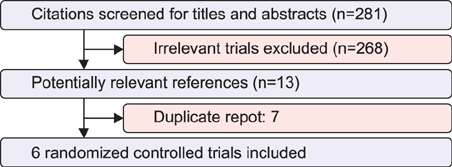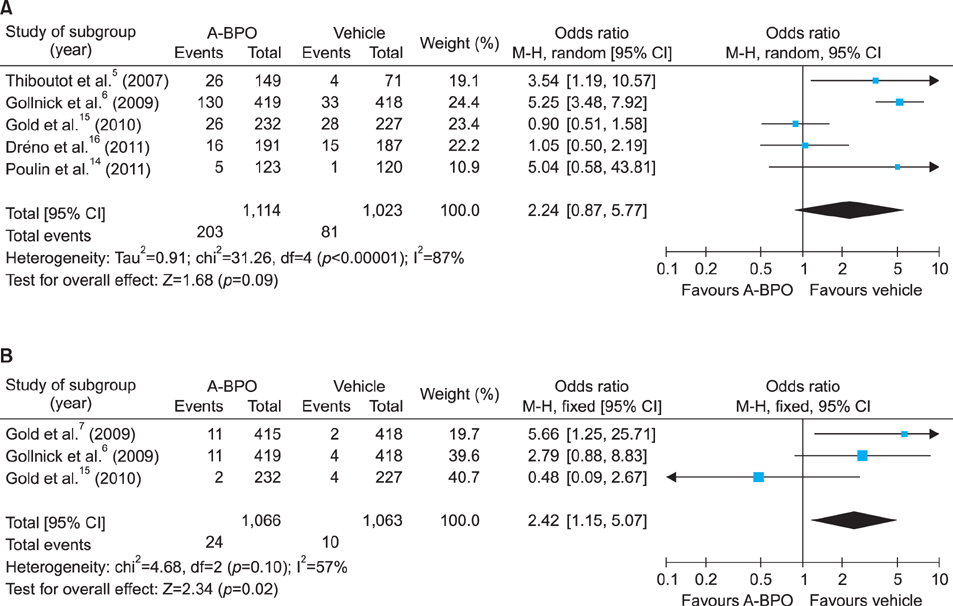Ann Dermatol.
2014 Feb;26(1):43-52. 10.5021/ad.2014.26.1.43.
Effects of Adapalene-Benzoyl Peroxide Combination Gel in Treatment or Maintenance Therapy of Moderate or Severe Acne Vulgaris: A Meta-Analysis
- Affiliations
-
- 1Department of Dermatology, West China Hospital, Sichuan University, Chengdu, China. 332689856@qq.com
- KMID: 2265696
- DOI: http://doi.org/10.5021/ad.2014.26.1.43
Abstract
- BACKGROUND
An antibiotic-free, fixed-dose combination gel with adapalene (A) 0.1% and benzoyl peroxide (BPO) 2.5% has been developed for treatment of acne vulgaris.
OBJECTIVE
To compare the clinical outcomes of A-BPO combination gel with vehicle gel for treatment or maintenance therapy of patients with acne vulgaris.
METHODS
An electronic search of the database PubMed (1966 to September 2012), Embase (1984 to September 2012), and Cochrane Controlled Trials Register (CENTRAL; 3rd Quarter, 2012) was undertaken to identify relevant studies. Main clinical outcomes were success rate, treatment-related adverse events (AEs), AEs leading to discontinuation, satisfaction with the effectiveness, and overall satisfaction.
RESULTS
Six studies were finally included in this meta-analysis. The A-BPO group yielded better clinical outcomes regarding the success rate (p<0.00001), satisfaction with the effectiveness of treatment (p=0.005), and overall satisfaction (p=0.005) compared to the vehicle group. The incidence of treatment-related AEs in the A-BPO group was comparable with that of vehicle group (p=0.09), while the A-BPO group was associated with a slightly increase in the incidence of AEs leading to discontinuation when compared with the vehicle group (p=0.02).
CONCLUSION
A-BPO combination gel yields better clinical outcomes including success rate, satisfaction with the effectiveness, and overall satisfaction compared to vehicle gel, despite an increased incidence of AEs leading to discontinuation. The A-BPO combination agent most likely contributes to the treatment of moderate acne vulgaris rather than severe acne vulgaris, but it may be useful in maintenance therapy of patients with severe acne vulgaris.
Keyword
Figure
Reference
-
1. Pawin H, Beylot C, Chivot M, Faure M, Poli F, Revuz J, et al. Physiopathology of acne vulgaris: recent data, new understanding of the treatments. Eur J Dermatol. 2004; 14:4–12.2. Gollnick HP, Finlay AY, Shear N. Global Alliance to Improve Outcomes in Acne. Can we define acne as a chronic disease? If so, how and when? Am J Clin Dermatol. 2008; 9:279–284.3. Leyden JJ. A review of the use of combination therapies for the treatment of acne vulgaris. J Am Acad Dermatol. 2003; 49:3 Suppl. S200–S210.
Article4. Gollnick H, Cunliffe W, Berson D, Dreno B, Finlay A, Leyden JJ, et al. Management of acne: a report from a Global Alliance to Improve Outcomes in Acne. J Am Acad Dermatol. 2003; 49:1 Suppl. S1–S37.5. Thiboutot DM, Weiss J, Bucko A, Eichenfield L, Jones T, Clark S, et al. Adapalene-benzoyl peroxide, a fixed-dose combination for the treatment of acne vulgaris: results of a multicenter, randomized double-blind, controlled study. J Am Acad Dermatol. 2007; 57:791–799.
Article6. Gollnick HP, Draelos Z, Glenn MJ, Rosoph LA, Kaszuba A, Cornelison R, et al. Adapalene-benzoyl peroxide, a unique fixed-dose combination topical gel for the treatment of acne vulgaris: a transatlantic, randomized, double-blind, controlled study in 1670 patients. Br J Dermatol. 2009; 161:1180–1189.
Article7. Gold LS, Tan J, Cruz-Santana A, Papp K, Poulin Y, Schlessinger J, et al. A North American study of adapalene-benzoyl peroxide combination gel in the treatment of acne. Cutis. 2009; 84:110–116.8. Pariser DM, Westmoreland P, Morris A, Gold MH, Liu Y, Graeber M. Long-term safety and efficacy of a unique fixed-dose combination gel of adapalene 0.1% and benzoyl peroxide 2.5% for the treatment of acne vulgaris. J Drugs Dermatol. 2007; 6:899–905.
Article9. Gollnick H, Schramm M. Topical drug treatment in acne. Dermatology. 1998; 196:119–125.
Article10. Michel S, Jomard A, Démarchez M. Pharmacology of adapalene. Br J Dermatol. 1998; 139:Suppl 52. 3–7.
Article11. Shroot B, Michel S. Pharmacology and chemistry of adapalene. J Am Acad Dermatol. 1997; 36:S96–S103.
Article12. Bikowski JB. Clinical experience results with clindamycin 1% benzoyl peroxide 5% gel (Duac) as monotherapy and in combination. J Drugs Dermatol. 2005; 4:164–171.13. Martin B, Meunier C, Montels D, Watts O. Chemical stability of adapalene and tretinoin when combined with benzoyl peroxide in presence and in absence of visible light and ultraviolet radiation. Br J Dermatol. 1998; 139:Suppl 52. 8–11.
Article14. Poulin Y, Sanchez NP, Bucko A, Fowler J, Jarratt M, Kempers S, et al. A 6-month maintenance therapy with adapalene-benzoyl peroxide gel prevents relapse and continuously improves efficacy among patients with severe acne vulgaris: results of a randomized controlled trial. Br J Dermatol. 2011; 164:1376–1382.
Article15. Gold LS, Cruz A, Eichenfield L, Tan J, Jorizzo J, Kerrouche N, et al. Effective and safe combination therapy for severe acne vulgaris: a randomized, vehicle-controlled, double-blind study of adapalene 0.1%-benzoyl peroxide 2.5% fixed-dose combination gel with doxycycline hyclate 100 mg. Cutis. 2010; 85:94–104.16. Dréno B, Kaufmann R, Talarico S, Torres Lozada V, Rodríguez-Castellanos MA, Gómez-Flores M, et al. Combination therapy with adapalene-benzoyl peroxide and oral lymecycline in the treatment of moderate to severe acne vulgaris: a multicentre, randomized, double-blind controlled study. Br J Dermatol. 2011; 165:383–390.
Article17. Higgins JPT, Green S. Cochrane handbook for systematic reviews of interventions version 5.0.2 [Internet]. London: The Cochrane Collaboration;2008. updated September 2009. Available via DIALOG from: http://www.cochranehandbook.org.18. Loesche C, Pernin C, Poncet M. Adapalene 0.1% and benzoyl peroxide 2.5% as a fixed-dose combination gel is as well tolerated as the individual components alone in terms of cumulative irritancy. Eur J Dermatol. 2008; 18:524–526.19. Andres P, Pernin C, Poncet M. Adapalene-benzoyl peroxide once-daily, fixed-dose combination gel for the treatment of acne vulgaris: a randomized, bilateral (split-face), dose-assessment study of cutaneous tolerability in healthy participants. Cutis. 2008; 81:278–284.20. Eichenfield LE, Jorizzo JL, Dirschka T, Taub AF, Lynde C, Graeber M, et al. Treatment of 2,453 acne vulgaris patients aged 12-17 years with the fixed-dose adapalene-benzoyl peroxide combination topical gel: efficacy and safety. J Drugs Dermatol. 2010; 9:1395–1401.21. Feldman SR, Tan J, Poulin Y, Dirschka T, Kerrouche N, Manna V. The efficacy of adapalene-benzoyl peroxide combination increases with number of acne lesions. J Am Acad Dermatol. 2011; 64:1085–1091.
Article22. Tan J, Gollnick HP, Loesche C, Ma YM, Gold LS. Synergistic efficacy of adapalene 0.1%-benzoyl peroxide 2.5% in the treatment of 3855 acne vulgaris patients. J Dermatolog Treat. 2011; 22:197–205.
Article23. Tan J, Stein Gold L, Schlessinger J, Brodell R, Jones T, Cruz A, et al. Short-term combination therapy and long-term relapse prevention in the treatment of severe acne vulgaris. J Drugs Dermatol. 2012; 11:174–180.24. Brodell RT, Schlosser BJ, Rafal E, Toth D, Tyring S, Wertheimer A, et al. A fixed-dose combination of adapalene 0.1%-BPO 2.5% allows an early and sustained improvement in quality of life and patient treatment satisfaction in severe acne. J Dermatolog Treat. 2012; 23:26–34.
Article
- Full Text Links
- Actions
-
Cited
- CITED
-
- Close
- Share
- Similar articles
-
- Twice-per-week Application of an Adapalene-benzoyl Peroxide Fixed-dose Combination Gel as Maintenance Treatment for Acne Vulgaris in Adults
- Evaluation of the Efficacy, Safety, and Treatment-Related Skin Irritation of Adapalene-Benzoyl Peroxide Combination Gel and Adapalene Gel in Acne Patients: A Randomized Comparative Study
- A Study of the Effectiveness in the Treatment of Mild to Moderate Severity Acne with Adapalene-benzoyl Peroxide Fixed-dose Combination Gel (Epiduo(R))
- A Prospective Study about Application of Adapalene-benzoyl Peroxide-MLE Fixed Dose Combination Gel for the Treatment of Disease in Patients with Acne Vulgaris
- The Effect of Zinc Sulfate in Acnd Vulgaris





